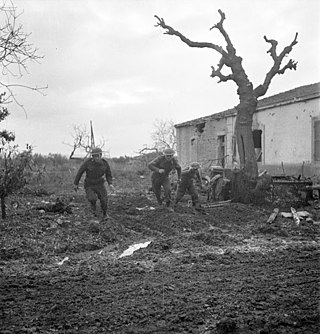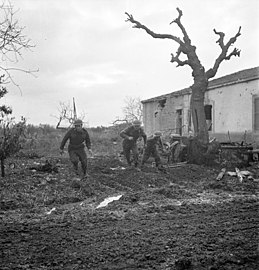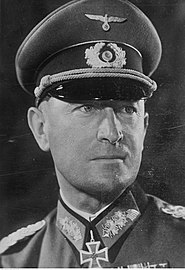
The Bernhardt Line was a German defensive line in Italy during the Italian Campaign of World War II. Having reached the Bernhardt Line at the start of December 1943, it took until mid-January 1944 for the U.S. Fifth Army to fight their way to the next line of defences, the Gustav Line. The line was defended by XIV Panzer Corps, part of the German Tenth Army.

Lieutenant-General Bernard Cyril Freyberg, 1st Baron Freyberg, was a British-born New Zealand soldier and Victoria Cross recipient, who served as the 7th Governor-General of New Zealand from 1946 to 1952.

I Corps was an army corps in existence as an active formation in the British Army for most of the 80 years from its creation in the First World War until the end of the Cold War, longer than any other corps. It had a short-lived precursor during the Waterloo Campaign.

Operation Baytown was an Allied amphibious landing on the mainland of Italy that took place on 3 September 1943, part of the Allied invasion of Italy, itself part of the Italian Campaign, during the Second World War.

The 2nd New Zealand Division, initially the New Zealand Division, was an infantry division of the New Zealand Military Forces during the Second World War. The division was commanded for most of its existence by Lieutenant-General Bernard C. Freyberg. It fought in Greece, Crete, the Western Desert and Italy. In the Western Desert Campaign, the division played a prominent role in the defeat of German and Italian forces in the Second Battle of El Alamein and the British Eighth Army's advance to Tunisia.

XXX Corps was a corps of the British Army during the Second World War. The corps was formed in the Western Desert in September 1941. It provided extensive service in the North African Campaign and many of its units were in action at the Second Battle of El Alamein in late 1942. It then took part in the Tunisia Campaign and formed the left flank during the Allied invasion of Sicily in 1943.

The Italian campaign of World War II, also called the Liberation of Italy following the German occupation in September 1943, consisted of Allied and Axis operations in and around Italy, from 1943 to 1945. The joint Allied Forces Headquarters (AFHQ) was operationally responsible for all Allied land forces in the Mediterranean theatre and it planned and led the invasion of Sicily in July 1943, followed in September by the invasion of the Italian mainland and the campaign in Italy until the surrender of the German Armed Forces in Italy in May 1945.

IV Corps was a corps-sized formation of the British Army, formed in both the First World War and the Second World War. During the First World War the corps served on the Western Front throughout its existence. During the Second World War it served in Norway and Britain until it was transferred to India, which was threatened with attack after Japan entered the war.

The II Corps was an army corps of the British Army formed in both the First World War and the Second World War. There had also been a short-lived II Corps during the Waterloo Campaign.

The Battle of Ortona was a battle fought between two battalions of elite German Fallschirmjäger (paratroops) from the German 1st Parachute Division under Generalleutnant Richard Heidrich, and assaulting Canadian troops from the 1st Canadian Infantry Division under Major General Christopher Vokes. It was the culmination of the fighting on the Adriatic front in Italy during "Bloody December". The battle was known to those who fought it as the "Italian Stalingrad," for the brutality of its close-quarters combat, which was only worsened by the chaotic rubble of the town and the many booby traps used by both sides. The battle took place in the small Adriatic Sea town of Ortona (Abruzzo), with a peacetime population of 10,000.

The Battle of the Mareth Line or the Battle of Mareth was an attack in the Second World War by the British Eighth Army in Tunisia, against the Mareth Line held by the Italo-German 1st Army. It was the first big operation by the Eighth Army since the Second Battle of El Alamein 4+1⁄2 months previously. On 19 March 1943, Operation Pugilist, the first British attack, established a bridgehead but a break-out attempt was defeated by Axis counter-attacks. Pugilist established an alternative route of attack and Operation Supercharge II, an outflanking manoeuvre via the Tebaga Gap was planned. Montgomery reinforced the flanking attack, which from 26 to 31 March, forced the 1st Army to retreat to Wadi Akarit, another 40 mi (64 km) back in Tunisia.

The 78th Infantry Division, also known as the Battleaxe Division, was an infantry division of the British Army, raised during the Second World War that fought, with great distinction, in Tunisia, Sicily and Italy from late 1942–1945.

X Corps was a corps of the British Army that served in the First World War on the Western Front before being disbanded in 1919. The corps was re-formed in 1942 during the Second World War and saw service in the North African Campaign and the Italian Campaign where it came under command of the US Fifth Army and the British Eighth Army.
Gothic Line order of battle is a listing of the significant formations that were involved in Operation Olive, the Allied offensive on the Gothic Line in northern Italy, August–September 1944, and in the subsequent fighting in the central Apennine mountains and on the plains of eastern Emilia–Romagna up to April 1945.

Joachim Lemelsen was a German general during World War II who rose to army-level command.

The Moro River Campaign was an important battle of the Italian campaign during the Second World War, fought between elements of the British Eighth Army and LXXVI Panzer Corps of the German 10th Army. Lasting from 4 December 1943 to 4 January 1944, the campaign occurred primarily in the vicinity of the Moro River in eastern Italy. The campaign was designed as part of an offensive launched by General Sir Harold Alexander's Allied 15th Army Group, with the intention of breaching the German Army's Winter Line defensive system and advancing to Pescara—and eventually Rome.

The Second Battle of El Alamein was a battle of the Second World War that took place near the Egyptian railway halt of El Alamein. The First Battle of El Alamein and the Battle of Alam el Halfa had prevented the Axis from advancing further into Egypt.

13th Corps was a corps-sized formation of the British Army that fought on the Western Front during the First World War and was reformed for service during the Second World War, serving in the Mediterranean and Middle East throughout its service.

XII Corps was an army corps of the British Army that fought in the First and Second World Wars. In the First World War, it formed part of the British Salonika Force on the Macedonian front. In the Second World War, it formed part of the British Second Army during Operation Overlord and the subsequent North-West Europe Campaign of 1944-45.

The Spring 1945 offensive in Italy, codenamed Operation Grapeshot, was the final Allied attack during the Italian Campaign in the final stages of the Second World War. The attack into the Lombard Plain by the Allied 15th Army Group started on 6 April 1945 and ended on 2 May with the surrender of German forces in Italy.






















